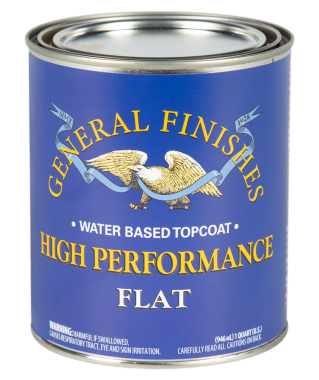All wood projects require preparation sanding. If you skip this critical step, your finish may fail.
Raw wood
See our video: How To Prep Sand New Wood
1. Sand no finer than 220 grit.
2. Remove dust.
New Stained Surface: Do not sand. Apply directly to the stained surface.
Pre-Finished Wood & Sealed Surfaces
See our video: How to Prepare Existing Finishes
- Scuff clean with a non-woven abrasive pad & 50:50 mix of denatured alcohol & water.
- Dry 1-2 hours.
- Sand lightly with 220-320-grit sanding sponge.
- Remove Dust
Other Substrates: Interior MDF, HDF, & Masonite
Can be used with proper preparation & priming. Always test first.
Step 2: How To Apply General Finishes High Performance
CAUTION: Do NOT use GF High Performance or any other clear coat, over white or light paints such as GF Milk Paint, or GF White Poly as it may cause yellowing. Any clear coat can become reactive over wood substrates or existing finishes causing tannin, stain or dye bleed-through. All of GF's White Paints, brushable or spray versions, do NOT require a topcoat.
NOTE: GF High Performance is tintable; however, GF does not have a color database. Tint at your own discretion and risk.
General Finishes High Performance Water Based Topcoat Application Steps for Raw Wood & Sealed Surface
- Watch the High Performance Product Overview Video Here (2:07)
- Work in a well-ventilated area.
- Stir thoroughly to reincorporate solids that have settled to the bottom of the can before and throughout the application process.
- Test for adhesion.
- Thin as desired with distilled water; start with 5%, adding up to 10% by volume.
- Increase open time, if needed, with 10-15% General Finishes Extender if allowed by local regulations. GF Extender will improve flow and leveling and increase open time, which is helpful in dry climates. California Residents: Adding more than 2% of GF Extender will make the product
snon-compliant per SCAQMD Regulations. GF assumes no liability for the improper use of these products. - Apply 2-3 coats of High Performance. No more than 3 coats is recommended. More coats will not improve durability.
- Hand application: Apply a liberal amount of product using a synthetic bristle brush, foam brush, pad applicator or roller such as Whizz or AllPro Velour brand. Avoid pressure and excessive back brushing. Brush along the wood grain using smooth, even strokes with light lap marks. Let lap marks dry - they WILL tighten down.
- Spray application: Before spraying, strain topcoat through a fine-mesh filter. Spray wet films at 3-5-mil thickness. HVLP: 1.1mm-1.3mm spray tip, medium air cap. Verify tip sizes with your equipment supplier. See our general guide for spray tip sizes. Keep your gun at a 90° angle, 6-8" from the surface. On large, flat areas, use wet, even patterns 6-8" wide. For narrow surfaces, reduce the fan pattern to 2-3" wide to reduce overspray. Overlap each pass 25% to conceal lines. Wear a full filter respirator (NIOSH/MSHA-approved) and work in a ventilated space.
- Face frames and drawers on cabinets: High Performance can be successfully applied by hand to cabinet face frames or edges with a brush, pad or small, cabinet-specific roller such as Whizz or AllPro Velour brand.
- If a faster build is desired over raw wood, use General Finishes Sanding Sealer for the first coat, followed by 2 coats of High Performance Topcoat.
- Finish sand between coats with a fine-grade (220-320) sanding pad to improve smoothness and adhesion. Do not use steel wool.
- Remove dust with a vacuum, compressed air, an oil-free tack cloth or a water-dampened rag.
Tips to prevent streaking during hand-application:
See our video: How to Prevent Streaking with Water Based Topcoat
- Use a semi-gloss or gloss sheen with little to no flatting agents. The more flatting agents, the more likely a topcoat will streak when applied.
- To avoid streaking with the flatter sheens, apply a liberal amount of product and avoid using pressure and back-brushing. Wipe along the wood grain using smooth, even strokes. For large surfaces, apply topcoat with a large applicator, such as a paint pad.
- Remove any streaks that occur by buffing with fine-grade (220-320) sanding pad, or sanding well and re-coating.
- For the smoothest result, apply with a spray gun.
Mixing Sheens
Dead Flat sheen CAN NOT be mixed with another sheen because a completely different polymer is used and the combined formulas will not perform well as one. You mix can GF High Performance Topcoat Flat, Satin, Semi-gloss and Gloss sheens to adjust your sheen. For example, you can mix High Performance Flat and High Performance Gloss to obtain a different sheen.
Tinting
GF High Performance is tintable; however, GF does not have a color database. Tint at your own discretion and risk.
Warning: Do not use water-based products with Linseed Oils or Danish Oils.
Dry Time based on ideal conditions of 70°F 21°C; 50% humidity.
Dry time: 2+ hours in ideal conditions
Be sure to allow adequate dry time. You can tell if a water-based finish is dry if it forms a powder when lightly sanded with a fine-grade (220-320) foam sanding pad or 400-grit sandpaper. If in doubt, wait longer. Rushing the dry time can cause "blush," which is clouding in the finish due to moisture trapped between the layers.
Increase dry time if:
- Humidity is over 80%
- Temperatures are cooler.
- 3+ coats are applied
- Thick coats are applied
- Applying over an existing sealed finish
- Applying over products from other brands
- Layering General Finishes water- and oil-based products:
- Water over oil: Let oil-based products dry 72+hr before applying water-based products
- Oil over water: Let water-based products dry 24+hr before applying oil-based products
- To accelerate dry time in humid conditions, add General Finishes Accelerator and work in a space with good ventilation and air movement. If you decide to re-coat before the recommended time, test dryness.
Yellowing & Clear Topcoat
As is true of most "water-white" topcoats, General Finishes water-based topcoats dry clear over non-reactive substrates, such as plastic or metal, except General Finishes Enduro-Var, which ambers. When white paint sealed with a water-white topcoat is applied to something as unpredictable as wood, all bets are off and the reason for yellowing is often unknown. It can be caused by topcoat activating tannins in raw wood or aniline dyes, stains, or contaminants in a pre-existing finish. This is most evident when using BRIGHT WHITE paint and most prevalent in sculpted details of furniture where the topcoat can collect, intensifying color change to an unacceptable level.
There is no reliable way to predict whether yellowing will occur and to what degree. Every existing finish is different and we rarely know the finishing provenance on an existing piece. Every tree is different and every piece of wood is unique. Raw wood can bleed tannins immediately after the topcoat dries or months later with seasonal temperature changes. Oak, pine, mahogany, and Douglas fir are particularly prone to bleed-through.
Summary
- Whites have a lower “hide” quality and are more transparent than most other colors. Nearly all bright whites require additional coats to achieve the desired color and minimize color variation. This can increase the cost of paint finishing. Always include a clause in your contracts addressing the need for additional coats to achieve coverage.
- All bright white paint will yellow slightly with time, with or without topcoat. You have probably tried to touch up white woodwork in your home after several years and noticed the new paint is brighter.
- The underlying finish or wood species can affect the final color of light paint.
- Details and inside corners are difficult to cover with any paint color, but it tends to be more noticeable with whites. This is a naturally occurring phenomenon in paint application and does not necessarily constitute a defect in the paint finish or your technique.
- The more porous the paint, such as a chalk paint, the more likely that yellowing will occur. The topcoat is seeping through the spaces caused by the larger particles of filler that give Chalk Paints their texture.
Tips to Prevent Yellowing
- If it is a low-use project, use a premium white paint that is self-sealing and does not require a topcoat. A clear topcoat is not required on General Finishes Milk Paint for increased durability, as it is a self-sealing, exterior-rated coating with high durability and chemical and water resistance. However, topcoats do provide a smooth surface that is easier to clean and boosts durability for high-use projects, such as tabletops and kitchen cabinets.
- Use a professional product such as General Finishes Enduro White Poly. It has "increased topcoat properties," is a standalone finish when 3 coats are applied, and does not require sealing with a topcoat.
- We recommend using General Finishes Stain Blocker, an engineered chemical barrier, to prevent persistent bleed-through for interior-use projects.
- Stain Blocker does not adhere to melamine cabinet veneers.
- Stain Blocker cannot be tinted.
- Always test your project's ENTIRE finishing schedule (from cleaning to topcoat) on an inside door or a more hidden area of the piece. This will not help if the yellowing occurs later, but at least you will know if there is an immediate problem.
- Avoid painting period furniture, such as a 1940s serpentine mahogany desk, with light colors. The pieces were often finished in stain that contained aniline dyes, which cast a pinkish bleed-through under light paint. Not every piece of furniture is suitable for upcycling with a light paint color. Pine, mahogany, and furniture of the 1940s and 50s are a red flag.
- Last, not all manufacturers' topcoats are compatible with other finishes and may react with a color change. Always follow best practices by not rushing, and testing to your satisfaction first.
Knots
Knots in wood tend to bleed and are dense, making paint and stain adhesion a challenge. Stain Blocker may improve adhesion and prevent bleed-through for painting projects. Pine knots are especially difficult to cover with white or light paints. If you decide to paint over them, apply 3 coats of Stain Blocker first; however, we cannot guarantee adhesion or bleed-through blockage. You are better off using a dark paint on pine.
Cleanup of Water Based Products
Application tools and materials containing water-based products can be cleaned with soap and water or General Finishes Brush & Gun Cleaner immediately after use.
Product Spills
Spills may be able to be removed from fabric and carpet if cleaned immediately with soap and water.
Disposal
Discard unused product and waste in an environmentally safe manner; check with local fire and health regulation.



 SDS: Water Based Topcoat High Performance: Dead Flat - 2022-05
SDS: Water Based Topcoat High Performance: Dead Flat - 2022-05 



